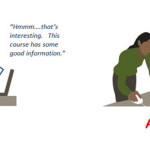
Many of us take a Field of Dreams approach to elearning. If we build it, they will learn. But the reality is that elearning is just an event in the timeline of learning and not the entire learning process. And in some ways, the elearning course is an intrusion on the person’s natural learning process. Because of this, we want to make sure that the investment we make in elearning produces the results we desire.

Sure enough, the elearning course is important because it can compress time and save resources. But the reality is that most of a person’s learning happens in the time before and after the elearning course. We looked at this briefly in a previous post, Ignore This Post If You Don’t Care About Effective Learning.
In today’s post I want to look at some things to consider before and after you build your elearning course. We’ll look at three core parts of the process.
- Motivated to Learn: How do you get people interested in what you have to offer?
- The E-Learning Course: Design the right instruction, visuals, and interactivity.
- Support Ongoing Learning: What happens the morning after?
1. Motivated to Learn

The elearning course is going to stick if the learners are motivated to learn. If they’re not, then odds are that while they complete the course, they’ll walk away from it without having learned much. There’s a lot that can be written about what motivates learners—definitely a lot more than I can cover in a simple blog post. But for today, we’ll touch on a few ideas to help you get started.
- Is this course relevant to the learners? If you’ve read this blog for a while, then you’ll know that this is a common question. Relevance is the key to effective and engaging elearning. You can forego some of the bells and whistles (and even interactivity) if the content of the course is relevant to the learners. Think about the last time you needed to learn something and did a search online. Some sites probably just had text and images, and some may have offered more interactive media. In either case, the main point of engagement was relevance. Was the site providing what you needed to learn? You probably didn’t stick around long if the site didn’t offer what you needed.
- Is this course practical? I’ve worked on courses where the client had grand notions of what should be taught, but was completely disconnected from the learner’s real world and how they used the information. In fact, I once built a course (brilliantly designed by the way) that ended up requiring the learners to spend hours in pre-work. They all complained about how long it took and how pointless the activities were (my fault). A brilliant course is only brilliant if it works. Learn about your learners and build courses that make sense to them and their world.
- How long is this going to take? I get lots of links to YouTube videos and other sites. The first thing I do is look at how long it is. If it’s less than two minutes, I’ll probably click on the link. Any longer than that and I’ve already decided it’s a waste of time. Guess what? Your learners probably do the same thing. They’re mentally doing a cost-benefit analysis. They want to know what type of commitment they have to make prior to taking the course. And they also want to understand what value they get. Can you provide that to them before they click next?
2. The E-Learning Course

Elearning course design has three core parts. You design the content, the look and feel, and the interactivity.
- What content needs to be in the course? There’s always more than enough content for most elearning courses. The challenge is usually figuring out what to get rid of more so than what to put it. I like Cathy Moore’s action mapping process. She does a great job helping you figure out how to make relevant courses without too much extra information. You can also manage the content better if you find ways to get the learners to pull what they need.
- What should the course look like? The visual design of your course is multifaceted. You want a course that looks good. But you need more than a great looking course. It also needs to visually communicate the context of your content. Focus on solid instructional design, but don’t neglect the aesthetic of the course. And remember, visual communication is an important part of instructional design when you work with a visual medium.
- What is the learner supposed to do with the content? You go through this process of building an elearning course and the ultimate question for the learner is, “So what?” How can you design the course so the learner has to use the content? You want them to interact with the course. In an ideal world, they get information, reflect on it, and practice using it all inside the course. This allows them to collect feedback and make the adjustments critical to the learning process.
3. Support Ongoing Learning

One of the biggest downfalls to elearning is the lack of support after the fact. I saw a study once that showed about 90% of the course budget was committed to the design and implementation of the course. Little was left over for post elearning support.
If you want the course to be successful, you need to consider what happens once the course is completed. Here are a few thoughts:
- Get the managers involved. They should do more than just forward a link to complete a course prior to December 31. Use the course as an opportunity for managers to coach their employees. For example, if someone takes a course on leading effective meetings, that’s probably a good time for the manager to assign some meetings to that person to see how well they do. She can then assess their understanding and provide ongoing feedback in a meaningful context.
- Leverage your organization’s social media technology. We don’t just learn t
hrough official channels. We learn from peers, managers, and customers. The problem is that many times this learning is lost to the organization. However, if you can create a shared practice community (or find other ways for people to regularly connect and share what they know) there’s a good chance that the learning continues and remains for others to benefit.
- Provide quick bursts of refresher training. People will remember more if you space out some of the learning. You can provide little follow-up sessions to the course where they get refresher content. I once designed a course for project managers. After the elearning course, we sent out a series of planned emails. They included some quick scenarios which they had to solve and then discuss with their managers. This helped them retain the information and it also gave them an opportunity to dialogue with their managers.
- Don’t lock the course behind the LMS. Elearning’s not cheap. The courses created are great resources but often are locked into the learning management system. Many times, you only get one shot at the course. Once you pass, it’s no longer available. If your system doesn’t provide access to the course after completing it, perhaps it makes sense to also make the course available somewhere else, like in a resource library.
Learning is a complex process. An elearning course is an important part or the process, but it isn’t the entire process. The secret to elearning success is to know how to tap into the learner’s need for the course content, to build the right type of course, and then to ensure that you have ongoing performance support.
What do you see as some of the challenges in these three steps? Share your thoughts here.
Events
Free E-Learning Resources




















0
comments